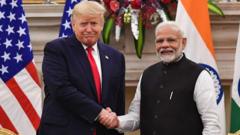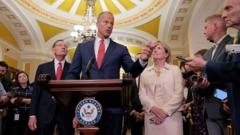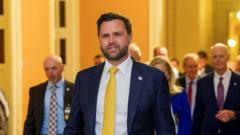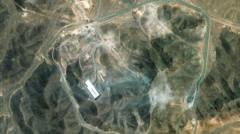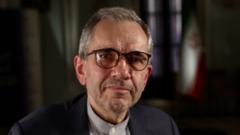In California's Bakersfield, Democratic leaders Alexandria Ocasio-Cortez and Bernie Sanders express outrage toward their party's leadership during a rally. The party, currently fragmented and struggling for cohesion, faces pressures from its base to provide a strong counter to Republican policies while debating the necessity of modernization and increased outreach to conservative voters.
Divergent Pathways: The Future of the Democratic Party Unfolds Amidst Internal Dissent
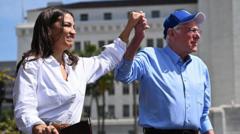
Divergent Pathways: The Future of the Democratic Party Unfolds Amidst Internal Dissent
As Democrats grapple with their direction in the wake of President Trump's policies, prominent figures propose varied strategies in response to voter dissatisfaction.
As the Democratic Party seeks a way forward amidst ongoing divisions, voices from both within and outside its ranks amplify calls for a united front. The rally in Bakersfield, California, featuring prominent figures like Congresswoman Alexandria Ocasio-Cortez and Independent Senator Bernie Sanders, served as a microcosm of the larger discourse surrounding the party's future. With Trump’s robust support in the surrounding areas, the packed local auditorium resonated with fervent calls for action against both the Republican Party and the perceived lethargy within Democratic leadership.
Local Democrats express significant dissatisfaction with how the party is responding to Trump’s agenda. Young attendees like Karla Alcantar voiced frustrations, asserting, “Some of them have just folded over completely,” and citing a desperate need for stronger opposition. This sentiment is echoed nationwide, as a recent CNN/SSRS poll revealed over half of Democrats and Democratic-leaning independents feeling the party is veering in the wrong direction, a stark contrast to their attitudes post-2016 election.
At the rally, sentiments reached a crescendo when Sanders and Ocasio-Cortez invoked themes of economic disparity, placing blame on not just Trump, but also wealthy figures such as Elon Musk. This “Fighting Oligarchy” campaign represents one approach to engaging disaffected constituents with a focus on economic justice. Ocasio-Cortez posed a question to the crowd, “Oligarchy or democracy?” signaling an ideological battle that resonates with many in the audience.
However, disunity remains a core issue as various factions within the party clash over strategy. Some Democrats argue for a shift toward the center, exemplified by California Governor Gavin Newsom’s outreach to ideological opponents, a move that has sparked backlash among traditional party supporters. In a landscape characterized by an age divide, younger leaders like David Hogg are advocating for fresh perspectives and significant reforms, even challenging established wisdom.
Faced with this generational tension, the question of how to express urgency and effectively respond to voters’ needs is central to ongoing discussions within the party. The Democratic base is yearning for a palpable commitment to opposing Republican initiatives rather than a passive approach.
While figures like Cory Booker are recognized for their fervent speeches against Trump, rally participants argue that action, especially when loud and visible, serves to signify that their leaders are engaged in the fight. As Democrats navigate these turbulent waters, fostering clear communication and action could be pivotal in redefining the party’s identity in an evolving political landscape. The rally in Bakersfield signals both the urgency for a collective stance and the challenges ahead in creating that unity.






